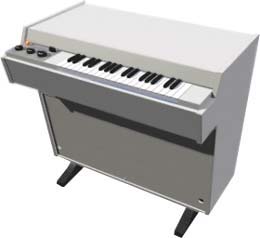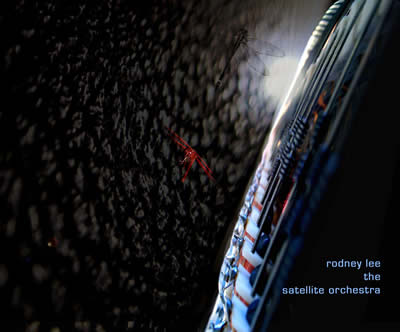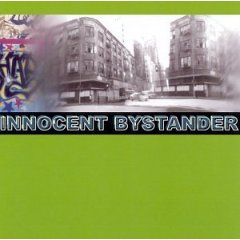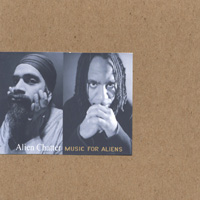|
The
Mellotron |

Weapon of Choice: Mellotron
The Mellotron is an electromechanical polyphonic keyboard musical
instrument originally developed and built in Birmingham, England in
the early 1960s.
The Mellotron (along with its direct ancestor the
Chamberlin) was, in effect, the world's first sample-playback
keyboard. The heart of the instrument is a bank of magnetic tape strips
(these tapes were parallel linear, not looped as has sometimes been
reported or presumed), each tape with approximately eight seconds
of playing time; playback heads underneath (but not directly underneath)
each key enables performers to play the pre-recorded sound assigned
to that key when pressed.
The earlier MKI and MKII models contained two side-by-side keyboards
with 18 selectable sets of specially-recorded sounds on the right
keyboard such as strings, flutes, and brass instruments which were
called "lead", or "instrument" sounds, and pre-recorded
accompaniment music (in various styles) on the left keyboard. The
tape banks for the later, lighter-weight M400 models contain three
selectable sounds (per changeable tape-rack) such as strings, cello,
and the famous eight-voice choir. The sound on each individual tape
piece is recorded at the specific pitch of the key that it was assigned
to.
Follow this link to see how a Mellotron works:
keyboardmuseum
-- click the key with your mouse
History
Although tape samplers had been explored in research studios (e.g.,
Hugh LeCaine's 1955 keyboard-controlled "Special Purpose Tape
Recorder", which he used when recording his classic "Dripsody"),
the first commercially available keyboard-driven tape instruments
were built and sold by California-based Harry Chamberlin from 1948
through the 1970s.
Things really took off, however, when Chamberlin's sales agent, Bill
Fransen, brought two of Chamberlin's instruments to England in 1962
to search for someone who could manufacture 70 matching tape heads
for future Chamberlins. Harry Chamberlin was not at all happy at first
with the fact that someone overseas was basically "copying"
his idea, and that one of his own people (Bill Fransen) was the reason
for this. He eventually found a UK company that were skilled enough
to develop the idea further and a deal was struck with Bill and Lesley
Bradley of tape recorder company Bradmatic Ltd. This resulted in the
formation of a subsidiary company named Mellotronics, which produced
the first Mellotrons in Aston, Birmingham, England. Bradmatic later
took on the name Streetly Electronics. Many years later, following
financial and trademark troubles, the Mellotron name became unavailable
and later instruments were sold under the name Novatron. A small number
of the instruments were assembled and sold by EMI under license.
Through the late 1970s, the Mellotron had a major impact on rock music,
particularly the 35 note (G-F) M400. The M400 was released in 1970
and sold over 1800 units, becoming a trademark sound of the era's
progressive bands. The novel characteristics of the instrument attracted
a number of celebrities, and among the early Mellotron owners were
Princess Margaret, Peter Sellers, King Hussein of Jordan and Scientology
founder L. Ron Hubbard.
Mellotrons were normally pre-loaded with string instrument and orchestral
sounds, although the tape bank could be removed with relative ease
by the owner and loaded with banks containing different sounds including
percussion loops, sound effects, or synthesizer-generated sounds,
to generate polyphonic electronically generated sounds in the days
before polyphonic synthesizers.
The unique sound of the Mellotron is produced by a combination of
characteristics of tape replay such as wow and flutter, the result
being that each time a note is played it is slightly different from
the previous time it was played (a bit like a conventional instrument).
The notes also interact with each other so that chords or even just
pairs of notes have an extremely powerful sound.
Although they enabled many bands to perform string, brass and choir
arrangements which had been previously impossible to recreate live,
Mellotrons were not without their disadvantages. Above all, they were
very expensive – they sold for £1,000 in the mid-1960s,
and the official Mellotron site gives the 1973 list price as US$5200.
Like the Hammond organ they were a roadie's nightmare – heavy,
bulky and fragile. After years of touring with Mellotrons, Robert
Fripp formulated a rule: "Tuning a mellotron doesn't." The
tape banks were also notoriously prone to breakages and jams and those
groups who could afford to (like Yes) typically took two Mellotrons
on tour with them to cope with the inevitable breakdowns.
The original Mellotrons (MkI/MkII) were not intended to be portable
(they often become misaligned when jostled even lightly), but later
models such as the M300, M400 and MkV were designed for portability.
All models, when installed permanently in a studio, provided a very
realistic effect. An example of this can be found on Elton John's
Goodbye Yellow Brick Road album.
Despite these shortcomings, Mellotrons were prized for their unique
sound, and they helped pave the way for the later sampler.
The Mellotron in popular music
British singer, songwriter and keyboardist Graham Bond might have
been the first rock musician to record with a Mellotron.
However, the Moody Blues and Mike Pinder
brought the Mellotron to the fore of popular music. In fact, Pinder
was the first to master and make regular use of the Mellotron in rock
music on the Moody Blues' studio albums from 1967 through 1971, while
their 1972 album Seventh Sojourn employed the Chamberlin. Mike Pinder
was formerly employed by Streetly Electronics and helped manufacture
them. Mike Pinder gave each of the The Beatles a Mellotron (which
they dubbed the Fabtron).The album "Days of Future Passed"
made use of the Mellotron in songs including "Nights in White
Satin" and "Tuesday Afternoon".
The Mellotron was also made famous by The Beatles,
who used it prominently on their groundbreaking 1967 single "Strawberry
Fields Forever", as well as several other recordings
they made in this psychedelic period. It was also used by The Zombies
("Changes"), The Rolling Stones ("2000
Light Years from Home"), Pink Floyd ("Julia
Dream"), David Bowie ("Space Oddity",
where it was played by Rick Wakeman) and others during
the psychedelic era. Rolling Stones' guitarist Brian Jones was supposedly
the first musician to master the instrument, using it liberally on
the album Their Satanic Majesties Request; his most remarkable performance
on the instrument was that for the band's 1967 single "We Love
You." The Kinks featured the instrument prominently in their
recordings between 1967 and 1969, particularly on the 1968 album The
Kinks are the Village Green Preservation Society.
The Mellotron was widely used to provide backing keyboard accompaniment
by many of the progressive rock groups of the 1970s and alongside
the venerable Hammond organ it was crucial to shaping the sound of
the genre. It features on albums such as Once Again by Barclay James
Harvest, In the Court of the Crimson King by King Crimson, Diamond
Dogs by David Bowie, 2112 by Rush (band), I Robot
by The Alan Parsons Project, Fragile and Close To The Edge
by Yes, and Foxtrot and Selling England By The Pound by Genesis.
Led Zeppelin used a Mellotron to recreate the recorder
arrangement for live performances of "Stairway to Heaven",
and is featured prominently on "Kashmir"
from Physical Graffiti and "The Rain Song" from
Houses of the Holy. It was also used extensively by pioneering
German electronic band Tangerine Dream through their prime, including
solo work by Edgar Froese. The Tangerine Dream albums Phaedra, Rubycon,
Ricochet, and Encore as well as Froese's Epsilon in Malaysian Pale
provide excellent examples of Mellotron playing.
The advent of cheaper and more reliable polysynths and preset 'string
machines' saw the Mellotron's popularity wane by the end of the 1970s.
Following the impact of punk, the Mellotron tended to be viewed as
a relic of a pompous era. By 1980 its status had diminished to the
extent that Captain Beefheart was able to reappropriate it almost
as an archaic "found instrument". One of the few UK post-punk
bands to utilize its sounds were Orchestral Manoeuvres in
the Dark, who featured it heavily on their platinum-selling
Architecture & Morality album (1981).
The Mellotron experienced a revival of sorts in the 1990s. A variety
of bands began using the instrument, including Marillion, Smashing
Pumpkins, Oasis, Nine Inch Nails,
Grandaddy, Radiohead, progressive rock band Porcupine
Tree, progressive metal band Opeth, and progressive jazz/rock band
Waterclime. On Porcupine Tree's 2005 album Deadwing, track six is
titled "Mellotron Scratch" and includes lyrics about the
sound of a Mellotron causing a woman to cry. In late '89/'90, R.E.M.
laid down those mysterious sounding cello parts that are so prevalent
in the cut "Losing My Religion", using
the Mellotron.
Woolly Wolstenholme of Barclay James Harvest still gigs and records
with a Mellotron, with both his own band Maestoso and with John Lees'
Barclay James Harvest. Although he now plays an M400 rather than the
M300 he is most famous for, his Maestoso albums Grim (2005) and One
Drop In A Dry World (2004) feature numerous examples of his use of
the M300 string sound that became his trademark.
In recent years, John Frusciante of funk-rockers the Red Hot
Chili Peppers has been known to use the mellotron, most notably
on 1999's Californication album, on the song of the same name. The
Mellotron can be heard in the track "Breaking the Girl"
on the album Blood Sugar Sex Magik. He also uses the mellotron prolifically
on his solo album "Shadows Collide With People".
The Strokes' 2006 album, First Impressions of Earth, features a Mellotron
solo on the track "Ask Me Anything". It is played live by
Nick Valensi, the lead guitarist.
Trent Reznor of Nine Inch Nails is known to possess
John Lennon's Mellotron, which he has used in several albums including
Marilyn Manson's Antichrist Superstar and the Nine Inch Nails album
The Downward Spiral.
-- courtesy of wikipedia
|
The
Mellotron in Action
| Track |
Listen
Further/Buy |
| Fiona Apple "Criminal" -- the string sounds |
|
| Radiohead "Exit Music (For a Film)" -- the choir
sound |
|
| Led Zeppelin "Rain Song" -- the string sounds |
|
| I
love the Mellotron because the sounds are loaded with character.
By today's standards the samples do not sound great, but they
have a special quality all their own that seem to breath life
into tracks. Owning and maintaining a Mellotron would be a little
too much for me (read above) so I use both samples from mellotron.com
and a VST plug-in made by GForce called the M-Tron ( see below
). In "Weird and Wonderful" you can hear how I used
it in the intro for a song from my current CD The Satellite
Orchestra. |
|
|
Mellotron
Emulations
The
Mellotron is fairly easy to emulate by simply sampling the 8-second
tape loop for each note.
| Product Name |
Manufacture |
Comments |
| Mellotron CD-ROM |
mellotron.com |
Really Great Samples of each key. This is as close to the
real thing as you are going to get. |
| M-Tron
VST Plug-in |
GForce |
I prefer the Mellotron CD-ROM samples overall, but there are
some really wicked sounds in this package as well. There is
the sound of a bass accordion that is dope. |
|
Links
to Mellotron Parts, Maintenance and more
Here
are a few links to some great Mellotron Sites
| mellotron.com |
Site of a Mellotron Guru. They also make a current
version called the MkIV for between 6-10,000 dollars!! |
| mellotronics.com |
The son of the original manufacturer of the Mellotron provides
repair and restoration services in the UK. And some new models. |
| youtube
video |
Vintage Mellotron Demo from the 60's. Really entertaining! |
| planetmellotron.com |
an exhaustive list of all of the albums that have used a mellotron |
|
|
| Current
Releases |

Rodney Lee -- The Satellite Orchestra

Innocent Bystander

Alien Chatter
featuring
Satnam Ramgotra &
Rodney Lee |

Need
Sheet Music Fast?
Download
Digital Sheet Music
from the number one source on the web
  |
|
